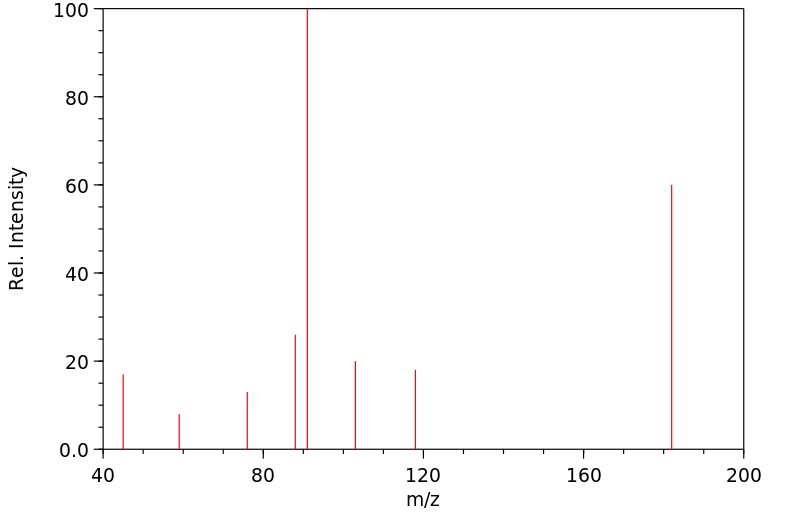Tetrathiooxalsaeure-dimethylester | 61485-47-0
中文名称
——
中文别名
——
英文名称
Tetrathiooxalsaeure-dimethylester
英文别名
dimethyl tetrathiooxalate;Dimethyl-tetrathiooxalat;dimethyl ethanebis(dithioate)
CAS
61485-47-0
化学式
C4H6S4
mdl
——
分子量
182.356
InChiKey
JPEQRYNXCNLOAJ-UHFFFAOYSA-N
BEILSTEIN
——
EINECS
——
-
物化性质
-
计算性质
-
ADMET
-
安全信息
-
SDS
-
制备方法与用途
-
上下游信息
-
文献信息
-
表征谱图
-
同类化合物
-
相关功能分类
-
相关结构分类
计算性质
-
辛醇/水分配系数(LogP):2.7
-
重原子数:8
-
可旋转键数:3
-
环数:0.0
-
sp3杂化的碳原子比例:0.5
-
拓扑面积:115
-
氢给体数:0
-
氢受体数:4
SDS
反应信息
-
作为反应物:描述:Tetrathiooxalsaeure-dimethylester 以50%的产率得到参考文献:名称:HARTKE K.; KISSEL T.; QUANTE J.; HENSSEN G., ANGEW. CHEM., 1978, 90, NO 12, 1016-1017摘要:DOI:
-
作为产物:描述:4,5-双(甲硫代)-1,3-二硫杂环戊烯-2-酮 以 二氯甲烷 为溶剂, 反应 1.0h, 以60%的产率得到Tetrathiooxalsaeure-dimethylester参考文献:名称:Hartke, Klaus; Kissel, Thomas; Quante, Josef, Chemische Berichte, 1980, vol. 113, # 5, p. 1898 - 1906摘要:DOI:
文献信息
-
Tetrathiafulvalene‐Fused Heterabuckybowl: Protonation‐Induced Electron Transfer and Self‐Sensitized Photooxidation作者:Lei Liu、Chaoxian Yan、Yecheng Li、Zhe Liu、Chengshan Yuan、Hao‐Li Zhang、Xiangfeng ShaoDOI:10.1002/chem.201905732日期:2020.6.2The electron donor tetrathiafulvalene (D1) was fused onto the electron‐rich heterabuckybowl trichalcogenasumanene (D2) through an electron‐deficient pyrazine unit (A) to give 1 c , 1 d , 2 c , and 2 d , featuring the D1–A–D2 structure. Both D1 and D2 play a pivotal role in intramolecular charge‐transfer (ICT) transitions, consequently 1 c , 2 d , 2 c , and 2 d show a broad ICT band at 450–720 nm in将电子给体四硫富瓦烯(D 1)通过缺电子的吡嗪单元(A)融合到富电子的杂巴三氯三亚苏曼烯(D 2)上,得到1 c,1 d,2 c和2 d,其特征为D 1 –A–D 2结构。D 1和D 2都在分子内电荷转移(ICT)跃迁中起关键作用,因此1 c,2 d,2 c和2 d在稳定状态下在450-720 nm处显示宽的ICT带。它们表现出两个电荷分离的瞬态CS1和CS 2依次出现。CS 1具有短的寿命(542个FS),以及d 1上CS部分1是在其最大吸收(自由基阳离子状态λ最大)在889纳米。CS 1然后转换成CS 2(λ最大,1105纳米)通过d之间的ICT 1 。+和d 2,得到d 1 (1- δ)。+和d 2 δ。+。化合物1 c,1 d,2 c和2 d显示质子化诱导的分子内电子转移,导致在λ = 700–1300 nm处吸收。由于D 1部分上存在富电子的C = C键,并且吡嗪融合的D 2部分原位生成1
-
Fetkenheuer,B.; Fetkenheuer,H.; Lecus, Chemische Berichte, 1927, vol. 60, p. 2530,2533,2536作者:Fetkenheuer,B.、Fetkenheuer,H.、LecusDOI:——日期:——
-
Hartke, Klaus; Kumar, Arvind; Henssen, Guenther, Chemische Berichte, 1982, vol. 115, # 9, p. 3107 - 3114作者:Hartke, Klaus、Kumar, Arvind、Henssen, Guenther、Quante, JosefDOI:——日期:——
-
Hartke, Klaus; Kumar, Arvind; Koester, Joachim, Liebigs Annalen der Chemie, 1983, # 2, p. 267 - 273作者:Hartke, Klaus、Kumar, Arvind、Koester, JoachimDOI:——日期:——
-
Gillmann, Thomas; Hartke, Klaus, Chemische Berichte, 1986, vol. 119, # 9, p. 2859 - 2867作者:Gillmann, Thomas、Hartke, KlausDOI:——日期:——
表征谱图
-
氢谱1HNMR
-
质谱MS
-
碳谱13CNMR
-
红外IR
-
拉曼Raman
-
峰位数据
-
峰位匹配
-
表征信息
同类化合物
黃原醯胺
金刚烷-2-硫酮
野麦畏
茵草敌
苯酚,2-氨基-5-氟-4-甲基-
硫菌威
硫草敌
硫胺甲酸乙酯
硫胺甲酸
硫代氨基甲酸S-(3-氯丙基)酯
硫代氨基甲酸S-(2-氯乙酯)
硫代氨基甲酰氯
硫代异丁酸S-(2-二甲氨基丙酯)
硫代丙酮
硫代丙烯醛
甲硫基-氨基甲酸 O-异丙基酯
甲基黄原酸钾
甲基硫代氨基甲酸异丁酯
环草敌
燕麦敌
烯丙基硫代氨基甲酸 O-乙酯
灭草敌
氯化甲氧羰基硫
氨基甲硫酸,十八烷基-,S-(3-氨基-2-甲氧基丙基)酯
氨基甲硫酸,二甲基-,S-(3-氯丙基)酯
杀螟丹
扑菌硫
戊烷-2-硫酮
庚烷-4-硫酮
庚烷-2-硫酮
己烷-3-硫酮
克草敌
二螺[5.1.5.1]十四烷-7,14-二硫酮
二硫代氯甲酸正丁酯
二硫代异丁酸乙酯
二硫代对苯醌
二硫代乙酸甲酯
二硫代乙酸烯丙酯
二硫代乙酸乙酯
二甲硫基氨基甲酸
二甲氨基硫代甲酰氯
二甲基硫代氨基甲酸 O-新戊基酯
二氰基二硫代乙酸甲酯
二戊基氨基硫代甲酸S-酸
二异丙基硫代氨基甲酸S-[(E)-2,3-二氯烯丙基]酯
二乙硫基氨基甲酸
二乙基硫代氨基甲酸 S-丁基酯
二乙基硫代氨基甲酰氯
二丙基氨基硫代甲酸S-酸
乙硫氨酯Z-200







